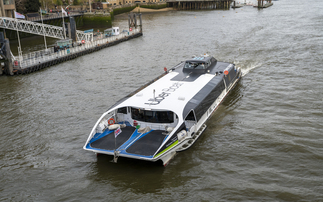French firm is banking big on hydrogen's potential to transform energy, transport, industry - and its own business - in pursuit of the UN's Sustainable Development Goals
Hydrogen has long been an exciting prospect for the low carbon transition. After all, it is an abundant gas, which can also be used as a liquid. You can store energy, heat homes, and fuel trucks, trains, and even ships with it. And at the point of use at least there are zero emissions, aside from a little water. All in all, it presents a compelling case for playing a key role in transforming industry, transport, and energy in pursuit of a net zero emission economy and the UN's Sustainable Development Goals (SDGs). Yet, for whatever reason - be it concerns over cost, efficiency, or the competitiveness rival technologies - hydrogen has often struggled to take off at scale.
However, a growing band of companies are working to transform hydrogen's status as a perennial runner up in the clean energy race. Air Liquide is one such firm. The French multinational is involved in the provision of gas, chemicals, and technologies for a number of different industries, but it is currently also investing heavily in the development of hydrogen infrastructure across Europe, North America, and Asia. The company wants to see H2 powering a sizeable chunk of the global economy within the next decade or two, but it also acknowledges that in order to open up those markets it first needs to put a complex set of building blocks in place.
"I think the difficulty, but also the beauty of hydrogen is that it is really a systemic solution, which is particularly suited to the issue we have with the energy transition," Pierre-Etienne Franc, vice president for Air Liquide's hydrogen energy world business unit, tells BusinessGreen. "It's a way to have a society living with abundant access to energy, but in a clean way."
At present, the company's main customers for its hydrogen products are found in the oil and gas industry, where H2 is used at petrochemical refineries to lower the sulphur content of diesel fuel. But if Air Liquide - which was founded more than a century ago in 1902 - is successful in delivering on its vision a global hydrogen value chain could spark huge transformation across multiple industries. That is because hydrogen can be created though several different approaches and has a vast number of potential uses that can enhance sustainability and boost resilience across different industries, explains Franc. The potential for the fuel to make a major contribution to the delivery of SDG9 and its targets to deliver sustainable infrastructure, industries, and innovation is obvious.
"Where it is changing, and where we are doing a lot of things now, is that if you move into energy transition topics, you need to use hydrogen in many other ways," says Franc. "This is where we are trying to push the system so as to create the dynamic for hydrogen to be one of the sustainable vectors for the energy transition."
Crucially, he explains, hydrogen is a very dense molecule capable of storing large amounts of energy, which makes it particularly useful for complementing intermittent sources of generation such as wind and solar. Through a process known as electrolysis, electricity from renewables can be used to produce hydrogen gas for storage or heating. Alternatively, that gas can be cooled and turned into a liquid state for use as a low carbon fuel for transport applications. The process for producing this zero emission or green hydrogen is well established, even if questions remain about the cost of the aproach.
However, hydrogen can also be created from fossil fuels, specifically via steam reforming of methane - aka natural gas - or industrial residue gases. Burning fossil fuels generates carbon dioxide, and therefore requires carbon capture storage or utilisation (CCUS) technologies in order to mitigate the climate impact. Known as 'blue hydrogen', the fuel opens up the potential for the fuel to play a key role in curbing emissions from fossil fuel power plants and industrial facilities.
For Air Liquide, both green and blue hydrogen have crucial roles to play. Its ambitious vision is to try and kick-start markets so it is involved in every aspect of hydrogen's production and utilisation in order to build a sustainable, resilient future for both itself, and the wider economy - key aims set out in the SDG9.
"We are doing a lot of investments to demonstrate or kick-start market development," says Franc. "We have been instigators and participating in the setup of key consortia to develop hydrogen distribution."
A 2017 report by the industry-led Hydrogen Council - of which Air Liquide is a member alongside other major players such as Shell, Toyota, and BMW - sought to plot a pathway for the global low carbon energy transition with hydrogen at the fore. It estimated hydrogen could meet 18 per cent of the world's energy demand by 2050, while powering 10 to 15 million cars and 500,000 trucks. To get to that scale, around $20-25bn global investment would be needed each year through to 2030, yet it estimated the hydrogen sector would have the potential to unlock $2.5tr in revenues and create 30 million jobs.
You can understand why these estimates are so high. There is an urgent need to develop zero emission means of operating transport - whether on the road, in the air, or across the sea - while energy-intensive industries remain one of the biggest challenges for countries seeking to deliver on the goals of the Paris Agreement. Car companies such as Toyota have therefore been pushing their Mirai hydrogen fuel cell cars, as has Nikola with its hydrogen trucks, with both able to travel further than a standard battery electric vehicle can on a single charge. Hydrogen fuel cell planes and ferries are also being developed, while hydrogen-powered trains are already in operation in Germany, and fuel cell technology is increasingly being seen as a means of balancing the electricity grid. Major steel companies such as ArcelorMittal, which has pledged to fully decarbonise its business by 2050, are also looking at hydrogen as a means of cutting emissions.
So if Air Liquide - already a large corporate player which has just posted over $12bn in sales for the first half of the year - managed to take just one per cent of those $2.5tr of those aforementioned hydrogen revenues forecast for 2050, it would double the size of the company, claims Franc.
"It's a very significant market, both because it is opening new verticals in the transport industry, which are not significant customers for us today," he says. "And second it's also renewing and enlarging the potential markets of our existing customer base, because today we supply the petrochemical industry, the refining industry, the steel industry, the glass industry, the cement industry, with many gases including hydrogen. But tomorrow they might extend the scope of their use of hydrogen as a substitute for fossil fuels, and they might ask us not to do hydrogen the way we do it today - using natural gas as a source for it - but to use clean technologies either through carbon capture or renewable sources of energy. That would be changing and enlarging the scope of what we do."
As such the company is losing no time in widening that scope. Its current overall production of hydrogen, largely for petrochemicals, stands at around 14 billion cubic metres, which it estimates would be enough to recharge around 10 million hydrogen fuel cell cars. But Air Liquide is expanding capacity further, in February announcing plans to install an electrolyser that will increase the current capacity of its hydrogen facility in Québec, Canada, by 50 per cent in order to meet growing demand for carbon-free hydrogen in North America. At 20MW, the electrolyser will be the largest of its kind in the world, Air Liquide claims, producing hydrogen for both industry and transport.
Elsewhere in North America, Air Liquide is constructing a $150m liquid hydrogen production plant in California, which it claims will be the first in the world dedicated solely to hydrogen energy markets, rather than petrochemicals. The plant has the capacity to produce almost 30 tonnes of hydrogen per day, and will initially supply FirstElement Fuel, which operates a number of hydrogen vehicle fuelling stations in the state. Like Japan, California is a major market for hydrogen fuel cell vehicles, and Air Liquide claims its facility will be able to provide enough fuel for all of the 40,000 such vehicles expected to be deployed in the state by 2022.
It doesn't stop there. In France, meanwhile, it is currently capturing CO2 from its natural gas-hydrogen production unit in Port-Jérôme, Normandy, both increasing hydrogen production efficiency while also delivering carbon dioxide utilisation in a variety of industrial purposes, including carbonation of sparkling beverages, food preservation, and freezing. That project is in addition to several facilities in Canada, which recover CO2 from ethanol suppliers.
And only last month Air Liquide announced a partnership that will see it provide a stable supply of hydrogen to German steelmaker ThyssenKrupp's integrated mills in Duisburg. The aim is to partially replace coal with hydrogen in the firm's blast furnaces with a view to cutting CO2 emissions in the steel production process by up to 20 per cent.
ThyssenKrupp's steel mill in the Rhine-Rhur region | Credit: ThyssenKrupp
There is another thread running through all of these projects: they are all found in industrialised countries. With little more than a decade to go until the UN's 2030 SDG targets are to be achieved, how can hydrogen play a part in the development of a sustainable global economy if only the world's richest countries can afford to put the required infrastructure in place?
Franc argues that in the short to medium term, countries with abundant renewable energy sources, particularly those in the southern hemisphere, will be able to use hydrogen as a means of exporting that power abroad, thereby boosting their economy and resilience. And in the longer term, development work on hydrogen today by developed countries can help bring down costs for less developed countries.
"So typically, for those either very sunny or windy countries which have a lot of space - some are capable of producing a gigantic amount of solar and wind available, which is far beyond what they need for their own development - it's going to become their new export," he predicts. "And when it is economically competitive, when we have networks of thousands of hydrogen stations and millions of cars on the streets, then of course the exportation of those technologies to less-well developed countries will be a lot less costly for them."
Yet hydrogen still has its detractors, who argue that for all its potential advantages, the infrastructure required - be it for CCS, vehicle refuelling or electrolysis - is too costly and the climate crisis too urgent, while in any case transferring electricity into hydrogen, and then back into energy, is too inefficient. Renewables and battery technologies, they argue, offer a more mature and cost effective alternative.
Franc, though, believes a number of key markets are beginning to shift in favour of hydrogen in a raft of different ways. Batteries alone do not provide requisite power nor range for heavy and long haul transport such as trucks, trains. and ferries, he argues, making fuel cells the more attractive option for many transport technology developers. China is investing heavily in hydrogen transport, which will deliver cost efficiencies for the rest of the world. And then there is the industrial side, where many commentators agree CCS is a necessity for decarbonisation, as will be shifting fuel sources for heavy industries.
"You need massive amounts of hydrogen for decarbonising hard to abate sectors - glass, steel, cement - and all the heat needs of the large process industries, and that is going to generate a lot of effort on the chemical industry side," he says. "All those elements are converging to create new momentum for hydrogen, which is supported by climate pressure from policymakers to move regulations, and also on industry to do things themselves."
As for concerns over hydrogen's efficiency, well, any shortcomings there are superseded by its ability to store and transport huge amounts of energy emission-free, he says. "That's what hydrogen brings you," Franc explains. "And it also brings you versatility because you can use it as a gas, as an electron, you can keep it for a long time, you can store it as a gas, or in liquid form, you can transport it."
Clearly much more policy support and investment is needed right across the global hydrogen chain, from electrolysis, to refuelling stations, road vehicles, planes, trains, ships, and CCUS in order to fully reap the benefits hydrogen offers. It is this wide-ranging infrastructure that remains the biggest barrier to hydrogen's adoption. After all, Air Liquide cannot create a global hydrogen economy all on its own, even if it is laying a lot of the groundwork at present.
But there are signs that a growing number of influential and deep-pocketed businesses are starting to seriously pursue the hydrogen opportunity, while policymakers are starting to recognise that few fuels offer the quite the same versatility and opportunities as hydrogen. Besides, Franc ultimately sees the major changes ahead for the oil and gas industry, and therefore his own company, as a necessity.
"Hydrogen really is the vector that is going to substitute oil - that's the view," he says. "The only issue is to progress faster now, as we don't have the time anymore because of climate change."









